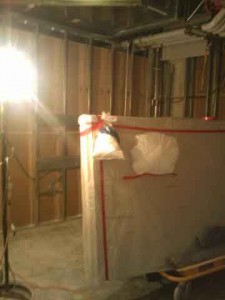Wed 10 Aug 2011
Lead Lined Sheetrock – installing
Posted by admin under Air Monitoring, Engineering Controls, HEPA, Lead, Leaded Sheetrock, Management, Respirators
[2] Comments
Leaded sheetrock is what the name says, sheetrock with a lead layer. It is used in hospital x-ray rooms and other health office clinics for containing / controlling the emitted x-rays while the machines are in use.
It is used in hospital x-ray rooms and other health office clinics for containing / controlling the emitted x-rays while the machines are in use.
Plastering / Drywall companies who install this type of drywall need to follow the OSHA Construction Rules for lead work. I have heard of airborne exposures being at the exposure limits (50 ug/m3) during the installation due to the cutting and breaking of the drywall. My own personal monitoring has been below the Action Limit (30 ug/m3), but I have consistently found levels above the detection limit. This information should be taken as a caution to others.
For starters the employer will need to provide:
- half face negative pressure tight fitting respirators with HEPA cartridges
- protective clothing (like Tyvek (R))
- containment (for the dust generated)
- training (in lead and respirators)
- hand washing / changing areas
- HEPA vacuums for clean up
- possibly air monitoring (by a qualified industrial hygienist)
- possibly blood lead testing
The sheetrock should be contained during transport. Installation should be performed in a contained area with employees in respirators who are trained and competent. Clean-up should be done with HEPA vacuums. Air monitoring should be performed to assure that employees were adequately protected during their activities.
Working with this type of material is no excuse to cut corners (no pun intended). Protect your employees, the hospital, the patients, and others.
regarding the construction industry, according to 1926.62b the action level for airborne concentration of lead is 30 micrograms/cubic meter of air. you mentioned that your monitering consistently put you over that number? could you share some of your findings? im an instructor who works with apprentices/journeyman who find themselves isntalling this product, and rarely are given any information about it.
thanks
Thank you for the comments. I have not performed enough sampling to verify or disprove the published information. I would suggest performing your own sampling in the conditions in which you typically work. I’m sure you’d agree, this would be the only way you could be assured you were controlling the possible exposure.